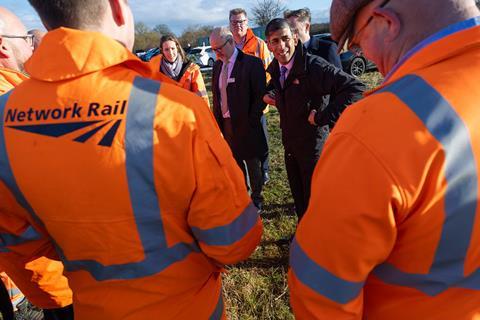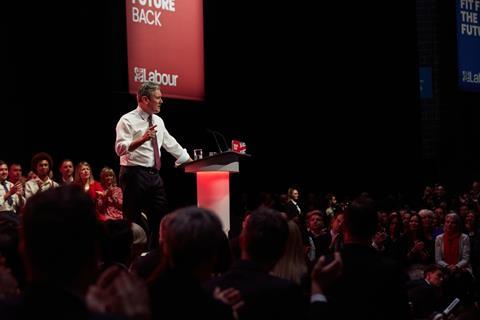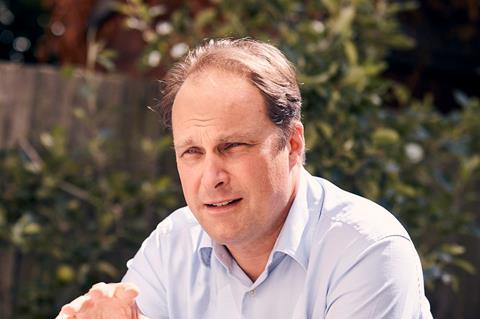Over the next few months, ║├╔½Ž╚╔·TV will have a political focus: what do the parties have to offer? What does construction want and need? Here is the final instalment of our three-parter with an overview of election topics

Infrastructure
The state of play
The National Infrastructure Commission last year laid out the task awaiting future governments to fix infrastructure in the UK over the coming decades. It calculated that ┬Ż30bn a year was needed from the taxpayer, with a further ┬Ż40bn to ┬Ż50bn a year from the private sector. This level of investment, the commission said, should be sustained until 2040.
The most famous ŌĆō or should that be infamous? ŌĆō infrastructure project of the lot is HS2, which has been pared back so much that the line is now being referred to by HS2 itself as one ŌĆ£which will almost halve journey times between BritainŌĆÖs two largest citiesŌĆØ. That was not really the plan; it was supposed to boost the whole of the UK economy.
>> Also read: Countdown to the general election part one: Project delivery, housing and planning, net zero
>> Also read: Countdown to the general elecion part two: ║├╔½Ž╚╔·TV safety, affordable housing, skills and education
But, while HS2 has hogged the headlines, there are other matters for political parties to deal with. To deliver net zero by 2050, the UK must be a long way down the road to decarbonising electricity, transport, industry and heating by the sixth carbon budget in 2035.
The NIC said the infrastructure concerns on politiciansŌĆÖ agendas should include ŌĆ£taking a clear decision that electrification is the only viable option for decarbonising buildings at scaleŌĆØ, investing in public transport upgrades ŌĆō both rail and road ŌĆō ŌĆ£ensuring gigabit-capable broadband is available nationwide by 2030 and supporting the market to roll out new 5G servicesŌĆØ, delivering additional water supply through new infrastructure, installing heat pumps and fully covering the cost for lower income households and investing in waste management to hit a target of 65% recycling by 2035.
What are the Conservatives saying?
The partyŌĆÖs big infrastructure story is that it has backpedalled on HS2. It is easy to forget that it was the Conservatives under David Cameron and Boris Johnson who championed the project.
The current prime minister, Rishi Sunak, appears much more lukewarm about the job. First, the Conservatives said the scheme, which has divided opinion between those who think it will level up the economy and those who think it is a catastrophic waste of money, would finish in London but not at the original Euston terminus.

Then Sunak cancelled the leg from Birmingham to Manchester last autumn. An alternative proposal, being stitched together by West Midlands and Greater Manchester mayors Andy Street and Andy Burnham, has not entirely been dismissed by transport secretary Mark Harper. The big sell is that it would have private funding ŌĆō but it also needs government support.
The wounds remain, however. Henri Murison, chief executive of the Northern Powerhouse Partnership, said a recent government announcement that ┬Ż4.7bn in funding that had been earmarked for HS2 will instead be given to councils in the north of England and the Midlands would not make up for the costs of cancelling HS2 to Manchester.
The image persists that the Tories have cut infrastructure, not grown it. But what is the party saying about other big UK projects?
Well, that LabourŌĆÖs ┬Ż28bn investment to meet the UKŌĆÖs net zero targets, shift the economy permanently to a low-carbon footing and create new green jobs, was unaffordable.
But that pledge has been abandoned and there has been little said on an alternative vision. Indeed, the main theme at last yearŌĆÖs Tory party conference was anti-green rhetoric, with Sunak warning about the costs of net zero policies.
In one of his biggest policy changes since taking office, ahead of last yearŌĆÖs conference, Sunak confirmed that the UK would push back the deadline for selling new petrol and diesel cars and the phasing out of gas boilers. The prime minister was ŌĆ£absolutely unequivocalŌĆØ about sticking to the commitment to reach net zero carbon emissions by 2050, but he wanted to take a ŌĆ£more pragmatic, proportionate and realistic approachŌĆØ. However, he set out little detail on what measures he would now bring in to help meet that target.
What is Labour saying?
The narrative around Labour and infrastructure revolves around what it is not saying about HS2 and the abandoned ┬Ż28bn green investment pledge, which it has drastically scaled back to under ┬Ż15bn a year.
Other schemes, including an ┬Ż8.3bn national energy supplier called Great British Energy, remain but putting a cost on its green energy pledge made the party, some of its MPs suggested, a hostage to fortune ŌĆō which is perhaps why it is not put any figures on the cost of HS2 alternatives.
Last October, the party said it would commission an independent inquiry into HS2 to work out how future infrastructure can avoid cost overruns. Two months later it appointed the former boss of Siemens Juergen Maier to lead a review into rail and transport infrastructure.

Labour is publicly not committing to reversing the HS2 decision ŌĆō lest it be accused of being profligate with taxpayersŌĆÖ money. It is, nonetheless, taking soundings about how the leg to Manchester could be built at less cost.
A wider review on infrastructure covering schools and hospitals has enlisted the help of several well-known names among its advisors. These include Mace chief executive Mark Reynolds, SkanskaŌĆÖs UK chief executive Katy Dowding and Mark Wild, who led the project to build the Elizabeth line before becoming chief executive at energy firm SGN.
It is clear that Labour sees improving infrastructure as a vote-winner, as well as being good for the country.
What the industry thinks
Alan Brookes, chief executive, Arcadis, says: ŌĆ£Labour is holding back on absolute detail. I think Labour will look at planning laws, but weŌĆÖve not seen any big commitments. We will watch what they say in detail and we will align to that.ŌĆØ
John Morgan, chief executive, Morgan Sindall, says: ŌĆ£Labour may spend more on housing but I wouldnŌĆÖt expect them to spend more on infrastructure. [Neither] have told us much. [Whoever wins], they wonŌĆÖt exactly find the coffers full of money to spend.ŌĆØ
Creating communities
The state of play
The Conservatives have dedicated significant time and political capital to addressing the placemaking agenda over the past decade, which they have controversially couched in terms of ŌĆ£beautyŌĆØ. Although sometimes characterised as a preference for purely backward-looking architecture, most who read Roger Scruton and Nicholas Boys SmithŌĆÖs ║├╔½Ž╚╔·TV Better, ║├╔½Ž╚╔·TV Beautiful CommissionŌĆÖs final report regarded it as sensible.
The report summarises what amounts to a growing global consensus around the desirability of traditional urban forms of development ŌĆō housing that addresses streets, in close proximity to quality green spaces and amenities, thereby reducing dependence on cars and facilitating healthier, more sociable places to live.

Meanwhile, the UK economy has increasingly struggled, achieving sluggish growth, accompanied by continued upheaval on the high street, with many big names disappearing and traditional town centres characterised by their large number of empty stores, together with the proliferation of charity shops and budget retailers.
Continued pressure on local authority budgets has seen civic amenities squeezed, with arts and community facilities most at threat.
Compulsory design codes, introduced by the Levelling-up and Regeneration Act 2023, should in theory empower local authorities to demand higher standards in design, but they are reporting widespread challenges with resourcing their planning departments.
The Conservatives have long been split on the question of sustainability, reflected in attitudes to 15-minute cities and car use. While the centre-right has been vocally supportive of transitioning to new green technologies and walkable, pedestrian-friendly environments, a libertarian faction is strongly opposed.
What are the Conservatives saying?
Since 2010 elements within the Conservative camp have shown an intense interest in issues relating to placemaking and the challenges of creating better quality communities, but with mixed results on the ground.
Several influential right-wing thinktanks, including The Centre for Policy Studies and Policy Exchange, have undertaken extensive research on the built environment, with their recommendations often being adopted into government legislation.
It was Policy ExchangeŌĆÖs 2018 ║├╔½Ž╚╔·TV More, ║├╔½Ž╚╔·TV Beautiful publication, that led to the creation of the ║├╔½Ž╚╔·TV Better, ║├╔½Ž╚╔·TV Beautiful Commission (BBBBC). Samuel Hughes of the Centre for Policy Studies has done much of the thinking behind ŌĆ£street votesŌĆØ, which are intended to enable the ŌĆ£gentle densificationŌĆØ of BritainŌĆÖs famously nimbyish suburbs.
Both organisations in turn influenced the Levelling-up and Regeneration Act 2023 and revised 2023 NPPF guidelines.
Michael Gove conceded that the ŌĆ£uncomfortable truth is that we have not built more because in many parts of the country there is a resistance to new developmentŌĆØ.
The theory behind the BBBBC and much Conservative policy-making has therefore been that only by improving the quality of new development will communities begin to accept and even welcome development.
In 2021 the Conservatives announced the creation of a new Office of Place, led by advocate for traditional urbanism Nicholas Boys Smith , with a mission to help ŌĆ£create beautiful, successful and enduring places that foster a sense of community, local pride and belonging.ŌĆØ
What is Labour saying ?
As in most other policy areas, Labour is not saying much publicly on the placemaking or built environment agenda, presumably wary of providing any hostages to fortune. Those who are sympathetic to the party are willing to give it the benefit of the doubt, believing that plenty of deep thinking has been going on behind the scenes.
Others fear a lack of engagement with constructionŌĆÖs issues. Whatever the reality, there is a notable absence of any key Labour figures with a professional background in construction, or strong personal interest in urbanism and design.
Although there has been strong rhetoric on sustainability, it is not easy to understand how it aligns with the partyŌĆÖs growth agenda and apparent commitment to building extensively on greenbelt and greenfield sites.

Hints at what a Labour government might mean for the placemaking and community-building agenda did emerge in Keir StarmerŌĆÖs Labour party conference speech in 2023, when he committed to a new generation of ŌĆ£Labour new townsŌĆØ on the ŌĆ£grey beltŌĆØ.
StarmerŌĆÖs rhetoric on creating new communities could mark a significant departure from current government policy, especially as it seems to be in marked contrast to the ConservativeŌĆÖs hesitancy around pushing through big developments.
As part of LabourŌĆÖs five missions for government, Starmer promised ŌĆ£shovels in the ground and cranes in the skyŌĆØ to deliver ŌĆ£more beautiful cities [and] more prosperous townsŌĆØ, demanding that ŌĆ£a future must be builtŌĆØ.
The Labour leader has described himself as a ŌĆ£yimbyŌĆØ, expressing a desire to ŌĆ£build a new BritainŌĆØ and ŌĆ£bulldozeŌĆØ his way through planning system.
In October Starmer pledged to build 1.5 million new homes during a Labour government. But his reasoning was that this would ŌĆ£recapture the dream of homeownershipŌĆØ for first-time buyers.
Offering more hope for those wanting to see a Labour commitment to new affordable homes, Angela Rayner has said: ŌĆ£The next Labour government will deliver the biggest boost to affordable, social and council housing for a generation, and get those social homes built, brick by brick.
ŌĆ£Developers have been let off the hook and for too long allowed to wriggle out of their responsibilities to provide new social and affordable homes. Labour will robustly hold them to account to deliver on their obligations to deliver affordable housing.ŌĆØ
Labour has had little to nothing to say in response to the ConservativeŌĆÖs ŌĆ£beautyŌĆØ agenda, or indeed on any qualitative or design aspects of the built environment agenda. However Starmer did reveal in a recent radio interview that his personal design preference was for ŌĆ£Georgian-style townhousesŌĆØ.
What the industry is saying
Jo Wright, managing director at Perkins and Will, says: ŌĆ£It would be great to see the government adopting an approach to whole-life carbon and maybe setting targets on a place basis.ŌĆØ
Election focus

As thoughts turn towards the next general election, the UK is facing some serious problems.
Low growth, flatlining productivity, question marks over net zero funding and capability, skills shortages and a worsening housing crisis all amount to a daunting in-tray for the next government.
This yearŌĆÖs general election therefore has very high stakes for the built environment and the economy as a whole. For this reason,
║├╔½Ž╚╔·TV is launching its most in-depth election coverage yet, helping the industry to understand the issues in play and helping to amplify constructionŌĆÖs voice so that the government hears it loud and clear.
We kick off this month with a three-parter looking at the state of play across three key topic areas.
║├╔½Ž╚╔·TV is investigating the funding gaps facing the next governmentŌĆÖs public sector building programmes, looking at the policy options available to the political parties.
In the coming months our ║├╔½Ž╚╔·TV Talks podcast will focus on perhaps the hottest political topic: the housing crisis. The podcast will feature interviews with top industry names who side-step soundbites in favour of in-depth discussions.
As the main parties ramp up their policy announcements, we will keep you up to date with their latest pledges on our website through our ŌĆ£policy trackerŌĆØ.


























No comments yet